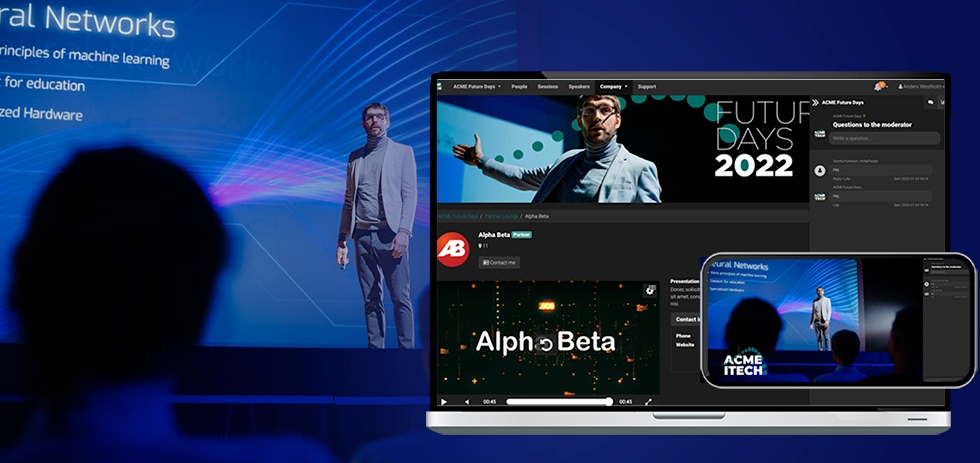

Can we continue to anticipate that employees will desire business trips?
During the pandemic, the abrupt change from physical to digital gatherings revealed the advantages and prospects of attending meetings and events digitally. This has resulted in increased employee expectations for employers and meeting approaches.
Being able to meet digitally simplified everyday life, not least through reduced requirements for business travel. Employers saw, among other things, gains in reduced travel costs. However, meeting physically at meetings and events has a clear advantage in establishing and developing customer relationships. Not only meeting digitally but also physically, is for many an important factor for well-being.
Employees now expect to be able to be flexible and participate in events digitally, but also need to meet physically when it suits them and the occasion best. These new expectations put pressure on companies to be able to deliver flexible participation as well as several different variants of meetings and events.
The transition to digital questioned the level of business travel
During the pandemic, everyone quickly had to switch from a work situation that often required physical presence in the office five days a week, and sometimes time-consuming business trips, to an almost completely digital presence.
The sudden change in the work situation affected the employees’ lives and well-being. Many studies and surveys have been done on the subject, where several results testify to the same thing: working remotely contributes to increased productivity and reduced stress levels among employees.

A contributing factor to this was the lack of commuting to the office and business trips. The employees have appreciated the extra time to better put together the puzzle of life. This has also strengthened the reluctance to travel as a part of the job.
Physical events, trade fairs, and conferences are important for companies to be able to showcase their products and services live to generate new leads, build customer relationships, and close deals. But the new distance habits adopted by workers during the pandemic have brought new demands on employers and the way they work and meet.
A desire for more on-site meetings
Many companies are screaming for physical events. Three out of five marketers say that it is very important, even crucial, to resume events where you meet on-site. However, when it has proved possible to work efficiently remotely and assimilate information without having to physically participate, workers are less likely to travel long distances to participate on-site.
New expectations from employees
Other important factors that speak in favor of a more flexible way of working are the improved accessibility made possible by digital events and the environmental aspects. Digital events can increase democratization and help even out social differences in society by making physical distances unimportant. This allows everyone to take part in information and participate in discussions, even if they are unable to move to a place due to disability, lack of time, or financial means.
The environmental aspects mainly show the large reduction in carbon dioxide emissions that would be made possible by a transition to digital events. The Swedish report Digital accessibility shows that a 30% transition to digital events would mean a reduction in carbon dioxide emissions by more than 500,000 tonnes in Sweden and financial gains of approximately SEK 40 billion. It could also free up travel time of 40 million hours that can be spent on work or leisure.
These positive effects of flexibility and inclusion are no longer seen as a luxury, but it is a matter of fact that it should be offered by employers. Companies not offering these benefits will find it more difficult to attract new talents.
A holistic view of events is required to meet expectations
The above-mentioned benefits and expectations are all good reasons not to return to what it was like before the pandemic. However, digital meetings and events will never be able to offer a perfect replacement for a physical meeting; an experience that is based on collective impressions from our different senses and that gives us a feeling of presence. This feeling is important for building relationships and creating commitment.

Hybrid meetings and events are for employees a good and flexible solution that includes several smaller physical events connected with digital components. It enables employees to meet, participate in discussions and assimilate information without having to travel unreasonably far.
However, hybrid solutions require more from the managers and organizers. It places high demands on technical competence, organizational ability, and being able to create a good experience for all participants, regardless of where they are.
Multidimensional solution that includes digital, physical, and hybrid
Although a hybrid event is a good solution from several perspectives, it is not a solution for all meeting and event needs. It is therefore important to be able to offer a mix of both digital, physical, and hybrid meetings to achieve the overall purpose where the different forms of meeting complement each other well.
Adaptation of meeting forms depending on the context and target group becomes essential to be able to meet the employees’ requirements and at the same time be able to deliver value seamlessly. It takes a holistic approach where each event and meeting is specialized and designed based on the company’s objectives.
By implementing a multidimensional strategy where each event and meeting has a clear goal, you can continuously create goal-focused events and meetings that meet the requirements for flexibility, inclusion, and social interaction.

